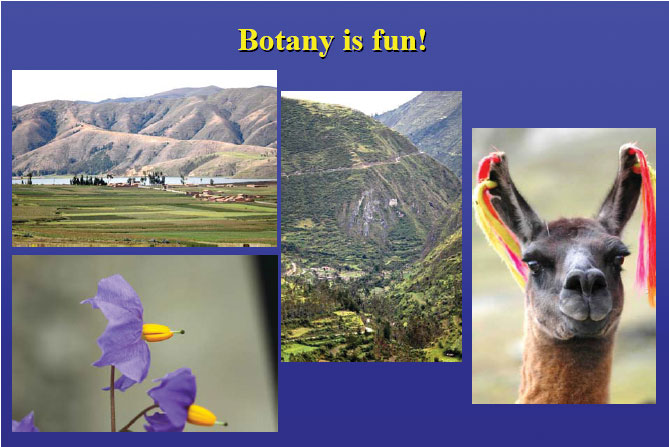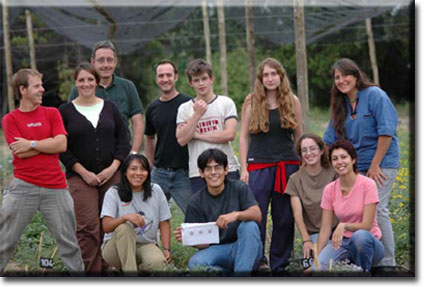
Ever since I could remember all I ever wanted to be was a botanist. As a child I pretty much lived in the various woods near our home in southwestern Ohio, and knew every trail and creek bed by heart. I spent hours climbing trees, turning over rocks looking for snakes and salamanders, and fishing. I was always curious about what the plants were called. Another dream was to be a traveler, and I still remember our first-grade reader that showed a guy who parked his convertible on a hilltop, overlooking far away vistas. I am still searching for that book, but my grade school has no record of their 1954 first grade readers.
I experienced my first "botany class" in fourth grade, when our teacher gave us an assignment to make a leaf collection and identify the trees. My parents helped me find a tree identification book in the local library and I was hooked on taxonomy for life. My teachers showed me Peterson's Field Guide to the Eastern Wildflowers, and I eventually used illustrated keys in Weishaup and Braun's floras of Ohio, Stausbaugh and Core's Flora of West Virginia, and Voss's Flora of Michigan.
I was lucky enough to go to Miami University in Ohio, and signed up for Hardy Eshbaugh's dendrology course as soon as I could, and took all the botany classes offered. After graduation I spent three years stationed in Washington DC in the Army, and spent weekends botanizing the Chesapeake and Ohio Canal towpath, Rock Creek Park, and the eastern seaboard. By that time I was using Gleason and Cronquist's Manual of Vascular Plants of the US and Adjacent Canada, and had a goal of knowing every plant in the flora area.
After the Army I received a Master's degree at Ohio University, and was first upset at my advisor Robert Lloyd for not letting me do research on Athens County floristics (doing surveys of plants in an area). At his insistence I delved into plant evolution books by Verne Grant, Ledyard Stebbins, and Davis and Heywood. Stebbins's Evolution Above the Species Level and his theories on apomixis and its effect on difficult species complexes became my new passion. I did my Master's research on an embryological study of a potentially apomictic plant, the wild mustard Dentaria laciniata. After graduation I bought a cabin in the southern Ohio hills, a stereoscopic microscope, and for two years lived alone identifying plants and thoroughly enjoying nature. It was a wonderful time I will never forget, and I lived the dream of a lifetime.
After that, I got a job as a field botanist for the Ohio Department of Natural Areas and Preserves and was able to put my plant identification skills and love of roaming to good use. It was a dream job, spending five months a year walking throughout much of southeastern Ohio looking for rare plants and potential new nature preserves. I never thought I would tire of that job, but I had to stop exploring southward at the Ohio River boundary. I always wanted to explore the tropics. This dream was fulfilled by getting admitted to Tod Stuessy's research program at Ohio State University. Stuessy treated his students as professionals from the first day and always addressed us as "The world's expert on whatever your study group was." It was a heady time, and I spent seven months collecting the genus Simsia throughout Central and South America. With plant systematists Daniel Crawford and Ronald Stuckey, Ohio State University was a wonderful place for systematics research. The best training I had there, to prepare me for the demands of a professional career, was mandatory attendance to the departmental seminar series, the socials meeting the speakers afterwards, presentation of my research on a yearly basis at state and national meetings, and evening journal club. It was frightening to present my work in front of a critical audience but it gave me confidence in my work and myself. Giving talks is now one of the favorite parts of my job.
After graduation I got my present job as a Research Botanist with the USDA Agricultural Research Service in the Vegetable Crops Research Unit in Madison Wisconsin. USDA scientists at this location are given faculty appointments at the University of Wisconsin and have to work through the tenure process to stay at this location. This truly is a dream job. The USDA hires and retains scientists to be leaders in their research areas, and productive scientists are given freedom to direct their own programs within the context of their job assignment. An active research program depends on funds. A recent NSF grant with Lynn Bohs, Michael Nee, and Sandra Knapp is focused on writing a world-wide monograph of Solanum (http://www.nhm.ac.uk/botany/databases/solanum/). Much of my time is spent writing grants and papers, and much of the productivity of the lab is due to Sarah Stephenson, the USDA lab technician (upper left) and graduate students, such as Flor Rodríguez and Francisco Villamon who perform lab and field work (below).
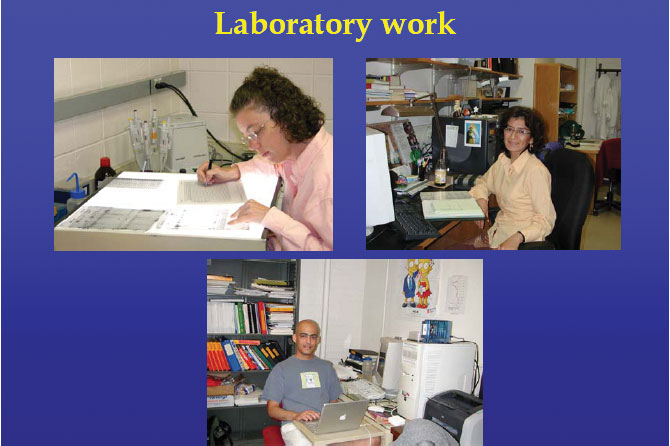
Wild and cultivated potatoes (botanically classified as the genus Solanum, section Petota) grow entirely in the Americas. About 30 species grow in North and Central America, and about 150 species in South America. They grow from the southwestern United States to southern Chile, in (beginning at upper left and going clockwise) dry deciduous forests (here in central Mexico), high upland grassland "punas" (western Venezuela), sea level (one of the hundreds of islands in the Chonos Archipelago in southern Chile), and rainforests (Bolivia near the Peruvian border). My USDA job assignment is to collect these species on yearly expeditions of two months each throughout the Americas. How cool is that? I then use these collections to study their species boundaries and relationships with modern morphological and molecular methods, such as marker data (as AFLPs), and DNA sequences of chloroplast and single-copy nuclear genes.
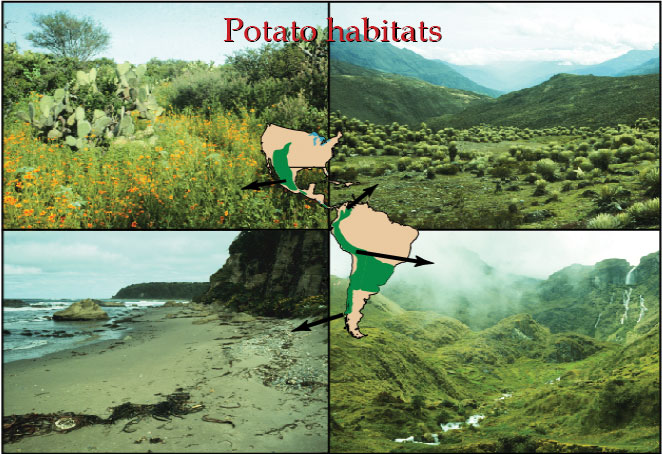
Collecting has been one of the most satisfying parts of my work, but requires a lot of preparation. One of the most important aspects of a collecting mission is to know all the species described from an area, so knowledge of your group through literature searches is critical. Once in a country, I also go to local herbaria to find additional localities for wild potatoes. These are then compared against genebank holdings to plan collection of the most important materials. I have collected potatoes every year for 14 years from 1988-2000 in Mexico (two expeditions), Guatemala, Honduras, Costa Rica, Panama, Venezuela, Colombia, Ecuador, Peru (two expeditions), Bolivia (two expeditions), Argentina, and Chile (two expeditions), and I spent six weeks in Nepal studying germplasm in other plant groups. Ideally, there is a knowledgeable collector who has spent a lifetime collecting in an area, such as Alberto Salas from the International Potato Center (CIP; upper left, Peru). Other memorable collecting expeditions were in Bolivia (with Maria Ugarte and Ronald van den Berg), Colombia (Raul Castillo, front, and Luis López), and Ecuador (showing an Andean village). The Convention on Biological Diversity has made many countries reconsider their collection regulations and has delayed collecting in many countries until they can reestablish their collecting guidelines.
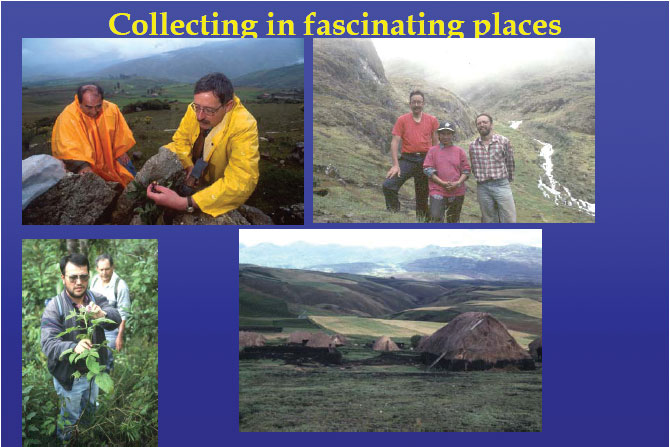
The USDA, and genebanks worldwide, fund these potato collecting trips and taxonomic work because the wild and native cultivated species have resistances to many of the diseases and pests that plague our potato crop, including (clockwise from upper left) late blight (the disease causing the Irish potato famine), scab, nematodes, and Erwinia tuber rot. Wild species also confer conferring resistance to a host of other pests such as Colorado potato beetle, resistances to environmental stresses such as frost, and improved agronomic and quality traits such as improved yield, colors, the ability to produce appealing light-colored potato chips, and better taste.
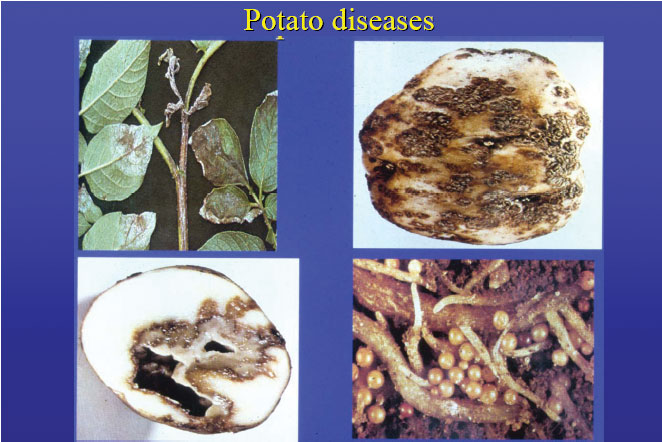
Traditionally, potatoes, as all plants, were classified mainly by their overall physical form (morphology). In potatoes, the corolla colors and shapes vary tremendously and have been important to classify these plants.
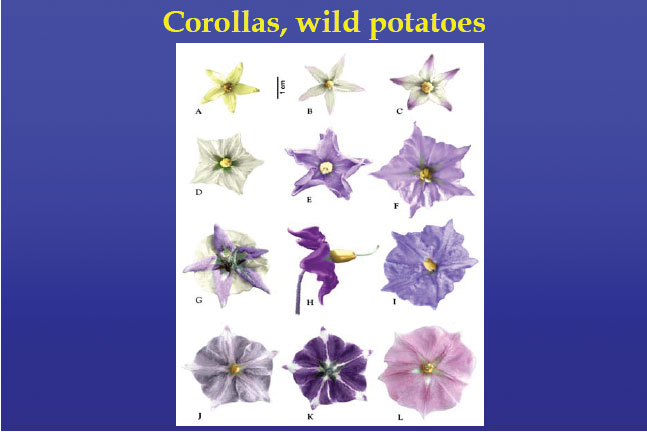
Fruits also vary and have been used taxonomically:
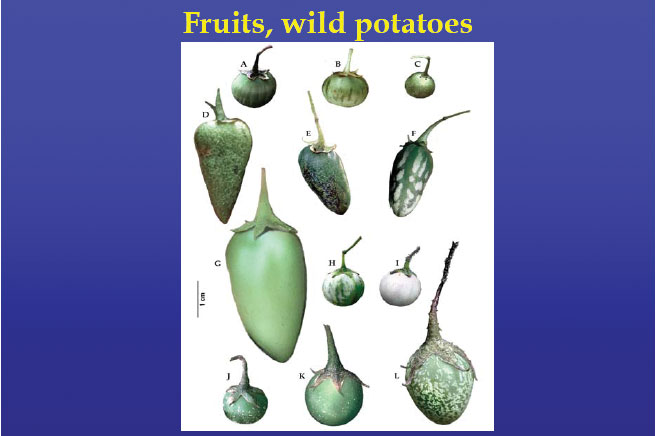
A tremendous advantage to working on crop plants is the availability of germplasm (living plant parts such as seeds) from germplasm "banks." Some my investigations, in collaboration with others, uses these germplasm collections for morphological studies of difficult species complexes, in replicated field trials, to test prior ideas of what constitutes a species. The photo below is one such study of the "Solanum brevicaule complex," conducted in a field plot in Wisconsin. The collaborators are Marie Ugarte (foreground, from Bolivia), my former student Joseph Miller, Julie Villand and I, and Dutch colleagues Ronald van den Berg and his former student Jouke Kardolus.
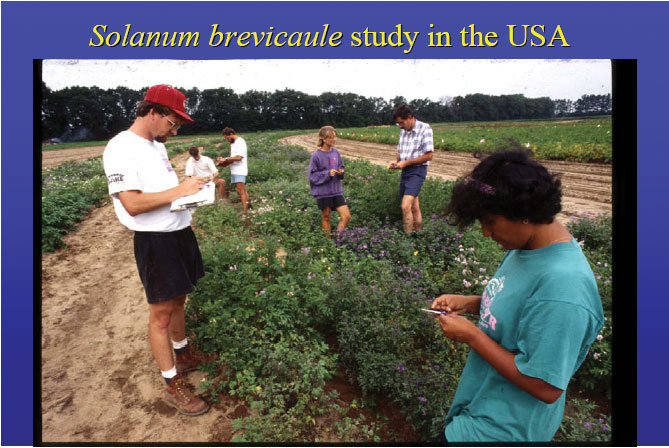
We conduct these studies together with various research programs worldwide, in order to test the effects of different environments, gain access to germplasm from different germplasm banks, and to enjoy the benefits of collaboration with different potato researchers. Below is a replicated field trial of the Solanum brevicaule complex in Mendoza, conducted in Argentina in 2005, with my former student Iris Peralta (standing, far right), a student on the NSF Solanum project Natalia Alvarez (sitting, far right), and Iris's other students from the National University of Cuyo Argentina, and me.
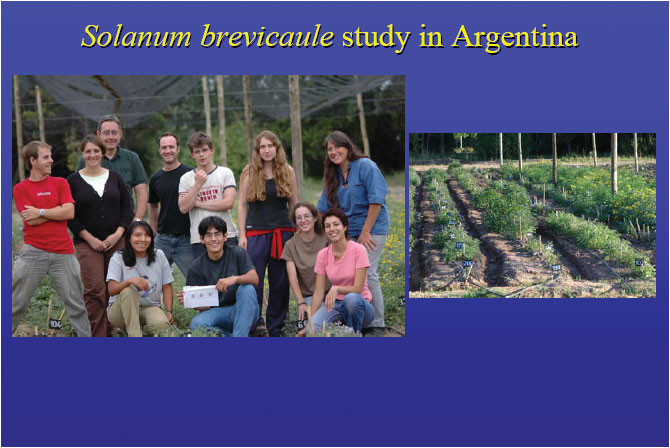
Similarly, another study was conducted of two other wild potato complexes in a field station of the International Potato Center in Huancayo Peru in central Andes, in collaboration with CIP's Willy Roca and Alberto Salas, and two other students of mine on the NSF Solanum project.
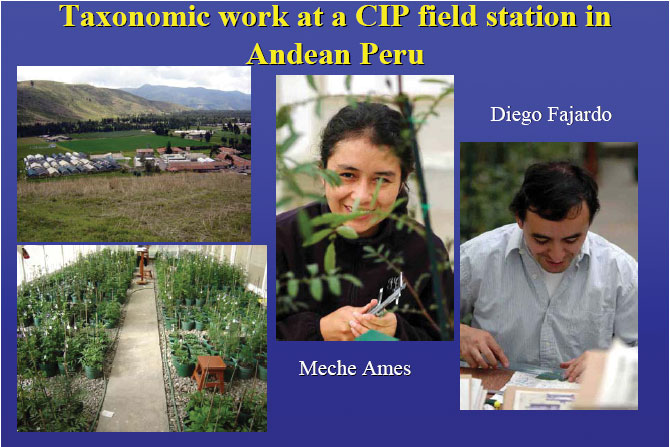
What an adventure this career has been! As you travel you are exposed to a wide variety of different things including foods:
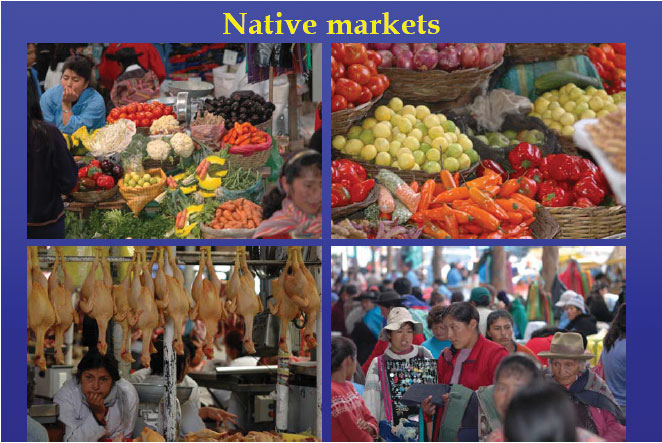
Cultures are very different. One of the most fascinating things about traveling in the Americas is to see different styles of dress; some villages have characteristic patterns in their clothes such as this little girl from Chiapas Mexico (left) or this woman from Tarabuco Bolivia. Sometimes you get lucky and collect during interesting times such as passing through this Peruvian village during holiday time. You forge lifetime friendships and collaborations as with CIP's Alberto Salas, one of the most knowledgeable potato taxonomists and collectors in the Americas.
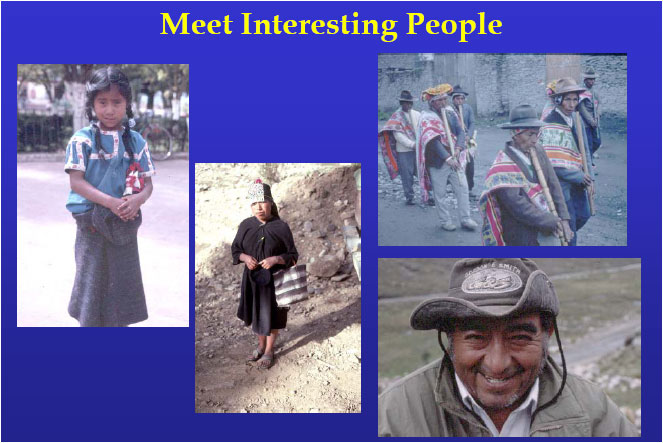
Do you want to follow a career in botany? As with any career, success depends on your productivity, and productivity follows hard work. But if you love what you do and are driven by it the hard work is fun work. I cannot imagine any other career being this much fun or rewarding. I have loved plants ever since I can remember and love to come to work every day. My advice? Get admitted to an active program, read as much as you can, present your work in front of journal club and local and national meetings, and become active in your professional societies. You would be surprised how many opportunities await motivated volunteers, how much you can change things, and how many new opportunities volunteering opens up to you. Does this seem like an interesting life to you? If so, don't look back and dive into this wonderful career. You will never regret it.
